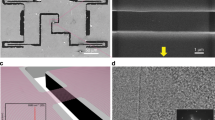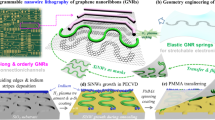Abstract
Graphene is nature's thinnest elastic material and displays exceptional mechanical1,2 and electronic properties3,4,5. Ripples are an intrinsic feature of graphene sheets6 and are expected to strongly influence electronic properties by inducing effective magnetic fields and changing local potentials7,8,9,10,11,12. The ability to control ripple structure in graphene could allow device design based on local strain13 and selective bandgap engineering14. Here, we report the first direct observation and controlled creation of one- and two-dimensional periodic ripples in suspended graphene sheets, using both spontaneously and thermally generated strains. We are able to control ripple orientation, wavelength and amplitude by controlling boundary conditions and making use of graphene's negative thermal expansion coefficient (TEC), which we measure to be much larger than that of graphite. These results elucidate the ripple formation process, which can be understood in terms of classical thin-film elasticity theory. This should lead to an improved understanding of suspended graphene devices15,16, a controlled engineering of thermal stress in large-scale graphene electronics, and a systematic investigation of the effect of ripples on the electronic properties of graphene.
This is a preview of subscription content, access via your institution
Access options
Subscribe to this journal
Receive 12 print issues and online access
$259.00 per year
only $21.58 per issue
Buy this article
- Purchase on Springer Link
- Instant access to full article PDF
Prices may be subject to local taxes which are calculated during checkout




Similar content being viewed by others
References
Bunch, J. S. et al. Electromechanical resonators from graphene sheets. Science 315, 490–493 (2007).
Lee, C., Wei, X. D., Kysar, J. W. & Hone, J. Measurement of the elastic properties and intrinsic strength of monolayer graphene. Science 321, 385–388 (2008).
Novoselov, K. S. et al. Two-dimensional gas of massless Dirac fermions in graphene. Nature 438, 197–200 (2005).
Zhang, Y. B., Tan, Y. W., Stormer, H. L. & Kim, P. Experimental observation of the quantum Hall effect and Berry's phase in graphene. Nature 438, 201–204 (2005).
Miao, F. et al. Phase coherent transport in graphene quantum billiards. Science 317, 1530–1533 (2007).
Meyer, J. C. et al. The structure of suspended graphene sheets. Nature 446, 60–63 (2007).
Guinea, F., Horovitz, B. & Le Doussal, P. Gauge field induced by ripples in graphene. Phys. Rev. B 77, 205421 (2008).
Guinea, F., Katsnelson, M. I. & Vozmediano, M. A. H. Midgap states and charge inhomogeneities in corrugated graphene. Phys. Rev. B 77, 075422 (2008).
de Parga, A. L. V. et al. Periodically rippled graphene: growth and spatially resolved electronic structure. Phys. Rev. Lett. 100, 056807 (2008).
Kim, E.-A. & Castro Neto, A. H. Graphene as an electronic membrane. Europhys. Lett. 84, 057007 (2008).
Katsnelson, M. I. & Geim, A. K. Electron scattering on microscopic corrugations in graphene. Phil. Trans. Roy. Soc. A 366, 195–204 (2008).
Morozov, S. V. et al. Giant intrinsic carrier mobilities in graphene and its bilayer. Phys. Rev. Lett. 100, 016602 (2008).
Pereira, V. M. & Castro Neto, A. H. All-graphene integrated circuits via strain engineering. Preprint at <http://arXiv.org/abs/0810.4539v1> (2008).
Elias, D. C. et al. Control of graphene's properties by reversible hydrogenation. Science 323, 610–613 (2009).
Du, X., Skachko, I., Barker, A. & Andrei, E. Y. Approaching ballistic transport in suspended graphene. Nature Nanotech. 3, 491–495 (2008).
Bolotin, K. I., Sikes, K. J., Hone, J., Stormer, H. L. & Kim, P. Temperature-dependent transport in suspended graphene. Phys. Rev. Lett. 101, 096802 (2008).
Cerda, E. & Mahadevan, L. Geometry and physics of wrinkling. Phys. Rev. Lett. 90, 074302 (2003).
Lifshitz, E. M. & Landau, L. D. Theory of Elasticity 3rd edn, Vol. 7 (Butterworth-Heinemann, 1986).
Zakharchenko, K. V., Katsnelson, M. I. & Fasolino, A. Finite temperature lattice properties of graphene beyond the quasiharmonic approximation. Phys. Rev. Lett. 102, 046808 (2009).
Scarpa, F., Adhikari, S. & Phani, A. S. Effective elastic mechanical properties of single layer graphene sheets. Nanotechnology 20, 065709 (2009).
Wong, Y. W. & Pellegrino, S. Wrinkled membranes. Part II: analytical models. J. Mech. Mater. Struct. 1, 25–29 (2006).
Blakslee, O. L., Proctor, D. G., Seldin, E. J., Spence, G. B. & Weng, T. Elastic constants of compression-annealed pyrolytic graphite. J. Appl. Phys. 41, 3373–3382 (1970).
Peyla, P. Buckling of a compressed elastic membrane: a simple model. Eur. Phys. J. B 48, 379–383 (2005).
Simon, M. E. & Varma, C. M. Dynamics of some constrained lattices. Phys. Rev. Lett. 86, 1781–1784 (2001).
Bowden, N., Brittain, S., Evans, A., Hutchinson, J. W. & Whitesides, G. M. Spontaneous formation of ordered structures in thin films of metals supported on an elastomeric polymer. Nature 393, 146–149 (1998).
Isacsson, A., Jonsson, L. M., Kinaret, J. M. & Jonson, M. Electronic superlattices in corrugated graphene. Phys. Rev. B 77, 035423 (2008).
Park, C. H., Son, Y. W., Yang, L., Cohen, M. L. & Louie, S. G. Electron beam supercollimation in graphene superlattices. Nano Lett. 8, 2920–2924 (2008).
Mounet, N. & Marzari, N. First-principles determination of the structural, vibrational and thermodynamic properties of diamond, graphite and derivatives. Phys. Rev. B 71, 205214 (2005).
Kwon, Y. K., Berber, S. & Tomanek, D. Thermal contraction of carbon fullerenes and nanotubes. Phys. Rev. Lett. 92, 015901 (2004).
Schelling, P. K. & Keblinski, R. Thermal expansion of carbon structures. Phys. Rev. B 68, 035425 (2003).
Watanabe, H., Yamada, N. & Okaji, M. Linear thermal expansion coefficient of silicon from 293 to 1,000 K. Int. J. Thermophys. 25, 221–236 (2004).
Wehling, T. O., Balatsky, A. V., Tsvelik, A. M., Katnelson, M. I. & Lichtenstein, A. I. Midgap states in corrugated graphene: ab-initio calculations and effective field theory. Europhys. Lett. 84, 017003 (2008).
Herbut, I. F., Juricic, V. & Vafek, O. Coulomb interaction, ripples and the minimal conductivity of graphene. Phys. Rev. Lett. 100, 046403 (2008).
Brey, L. & Palacios, J. J. Exchange-induced charge inhomogeneities in rippled neutral graphene. Phys. Rev. B 77, 041403 (2008).
de Juan, F., Cortijo, A. & Vozmediano, M. A. H. Charge inhomogeneities due to smooth ripples in graphene sheets. Phys. Rev. B 76, 165409 (2007).
Acknowledgements
We thank M. Bockrath and G. Xu for discussions, and B. Chim, D. Yan and Z. Zhao for assistance with SEM imaging. This research is supported in part by NSF/CAREER DMR/0748910, NSF/CBET 0756359, ONR N00014-09-1-0724 and ONR/DMEA H94003-09-2-0901. The trenches were fabricated at the UCSB nanofabrication facility.
Author information
Authors and Affiliations
Contributions
C.N.L. and W.B. conceived the experiments. C.N.L., C.D. and W.B. designed the experiments and interpreted the data. C.N.L., W.B., F.M. and H.Z. analysed the data. W.B., F.M., Z.C. and W.J. performed the experiments. Z.C. performed numerical simulations. C.N.L. and C.D. co-wrote the paper. All authors discussed the results and commented on the manuscript.
Corresponding author
Supplementary information
Supplementary information
Supplementary information (PDF 1603 kb)
Supplementary information
Supplementary movie (MOV 8439 kb)
Rights and permissions
About this article
Cite this article
Bao, W., Miao, F., Chen, Z. et al. Controlled ripple texturing of suspended graphene and ultrathin graphite membranes. Nature Nanotech 4, 562–566 (2009). https://doi.org/10.1038/nnano.2009.191
Received:
Accepted:
Published:
Issue Date:
DOI: https://doi.org/10.1038/nnano.2009.191
This article is cited by
-
Fabrication of angstrom-scale two-dimensional channels for mass transport
Nature Protocols (2024)
-
Free-electron interactions with van der Waals heterostructures: a source of focused X-ray radiation
Light: Science & Applications (2023)
-
Unidirectional motion of C60-based nanovehicles using hybrid substrates with temperature gradient
Scientific Reports (2023)
-
Free-standing 2D gallium nitride for electronic, excitonic, spintronic, piezoelectric, thermoplastic, and 6G wireless communication applications
NPG Asia Materials (2023)
-
Mechanics of 2D material bubbles
Nano Research (2023)



